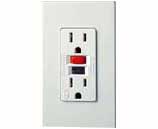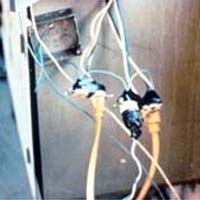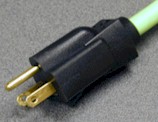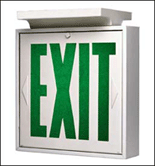Young Worker Safety in Restaurants eTool
Young Worker Safety in Restaurants » General Hazards

General Hazards
This section may be of interest to the young worker but is provided mainly for the employer. Other sections of this eTool reference this area for additional information. The following topics are covered:
Potential Hazards
Workers in restaurants are exposed to shocks and electrical hazards from:
- Worn electric cords or improperly used or damaged extension cords
- Improperly wired or ungrounded outlets
- Faulty equipment and wiring
- Damaged receptacles and connectors
- Wet clean-up processes
- Unsafe work practices
Possible Solutions
Employers have the primary responsibility for protecting the safety and health of their workers. Employees are responsible for following the safe work practices of their employers.

Consider implementing recommended safe work practices, including those discussed here. According to the National Institute for Occupational Safety and Health (NIOSH) most electrical hazards can be eliminated through safeguards and safe work practices such as:
-
Use ground fault circuit interrupters (GFCIs) of the breaker or receptacle type in situations where electricity and wetness coexist. GFCIs will interrupt the electrical circuit before current sufficient to cause death or serious injury has passed through a body. GFCIs are inexpensive ($50-$85 for breaker type, $25-$45 for receptacle type) and a qualified electrician can install them in existing electrical circuits with relative ease.
-
Employers should use ground-fault circuit interrupters (GCFIs) on all 120-volt, single-phase, and 15- and 20-ampere receptacles.

- Wear and tear on electrical equipment or tools can result in insulation breaks, short-circuits, and exposed wires. If there is no ground-fault protection, these can cause a ground-fault that sends current through the worker's body, resulting in electrical burns, explosions, fire, or death.
-
The GFCI is a fast-acting circuit breaker designed to shut off electric power in the event of a ground-fault and prevent injury to the worker.
-
Ensure that exposed receptacle boxes be made of nonconductive material so that contact with the box will not constitute a "ground."
-
Use plugs and receptacles designed to prevent energization until insertion is complete.
-
Ensure that all circuit breaker or fuse boxes bear a label for each circuit breaker or fuse that clearly identifies its corresponding outlets and fixtures. Also, breaker switches should not be used for on-off switches.
-
Inform all workers, when hired, of electrical hazards and of safe work practices by which to avoid these hazards. Workers should be informed that, in the event of an electrical injury, no contact should be made with the victim or the electrical apparatus causing the injury until the current has been shut off.
-
Encourage workers in restaurants to train in CPR.
Follow OSHA Standards including

1910 Subpart S - Electrical some highlights include:
-
Electrical equipment shall be free from recognized hazards [1910.303(b)(1)].
-
Listed or labeled equipment shall be used or installed in accordance with any instructions included in the listing or labeling [1910.303(b)(2)].
-
Sufficient access and working space shall be provided and maintained around all electric equipment to permit ready and safe operation and maintenance of such equipment [1910.303(g)(1)].
-

Ensure that all electrical service near sources of water is properly grounded [1910.304(g)(6)(vi)].
-
Tag out and remove from service all damaged receptacles and portable electrical equipment [1910.334(a)(2)(ii)].
-
Repair all damaged receptacles and portable electrical equipment before placing them back into service [1910.334(a)(2)(ii)].
-
Ensure that employees are trained not to plug or unplug energized equipment when their hands are wet [1910.334(a)(5)(i)].
Additional Information
-
Electrical. OSHA Safety and Health Topics Page.
-
Electrical Safety-Related Work Practices--Inspection Procedures and Interpretation Guidelines. OSHA Directive STD 01-16-007 [STD 1-16.7], (July 1, 1991).
-
Preventing Electrocutions of Workers in Fast Food Restaurants. National Institute of Occupational Safety and Health (NIOSH) Publication No. 85-104, (December 1984).
-
Preventing Electrocutions Due to Damaged Receptacles and Connectors. National Institute of Occupational Safety and Health (NIOSH) Publication No. 87-100, (October 1986).
Potential Hazards

Employee exposure to fire and fire hazards in restaurant work from:
-
Poor housekeeping
-
Un-emptied grease traps (possible grease fires)
-
Dirty ducts (possible flue fires)
-
Improper storage of flammable items
-
Faulty or frayed electrical cords
Possible Solutions

Employers have the primary responsibility for protecting the safety and health of their workers. Employees are responsible for following the safe work practices of their employers.

-
Provide procedures for regular maintenance of safeguards installed on heat-producing equipment to prevent the accidental ignition of combustible materials; [1910.39(c)(3)].
-
Inform employees upon initial assignment to a job of the fire hazards to which they are exposed. An employer must also review with each employee those parts of the fire prevention plan necessary for self-protection [1910.39(d)].
-
Follow the requirements of 1910.161, Dry Chemical Fire Extinguishers and 1910.160, Fixed Extinguishing Systems for fixed dry chemical extinguishing systems used to fight grease fires.
-
Ensure that electrical equipment is free from recognized hazards that are likely to cause death or serious physical harm to employees [1910.303(b)(1)].

-
Wiring methods, components, and equipment for general use [1910.305].
-
-
Provide exit routes, emergency action plans, and fire prevention plans.
-
Ensure that if fire extinguishers are required or provided in your workplace, and if anyone will be evacuating during a fire or other emergency, that you have an emergency action plan (EAP) and fire prevention plan [1910.157].
- Educate employees about the correct use of fire extinguishers if they are expected to fight fires as part of an emergency action plan [1910.157(g)(3)].
-
Training must include information about approved types of extinguishers [1910.157(c)(2)]. Class K fire extinguishers are approved in kitchens.
-
-
Provide for any area under construction or under maintenance including:

- Exit routes must be maintained during construction, repairs, or alterations [1910.37(d)].
- Employees must not occupy a workplace unless the exit routes required are available and existing fire protections are maintained, or until alternate fire protection is furnished that provides an equivalent level of safety [1910.37(d)(2)].
-
Employees must not be exposed to hazards of flammable or explosive substances or equipment used during construction, repairs, or alterations, that are beyond the normal permissible conditions in the workplace, or that would impede exiting the workplace [1910.37(d)(3)].

- For additional information on the requirements for exit routes, see the Evacuation Plans and Proceedures eTool - Maintenance, Safeguards, and Operational Features for Exit Routes
Additional Information
-
Fire Safety. OSHA Safety and Health Topics Page.
-
What should employers do to protect workers from fire hazards? OSHA Fact Sheet.
-
How to Plan for Workplace Emergencies and Evacuations. OSHA Publication 3088, (2001).
- Evacuation Plans and Procedures. OSHA eTool.
Potential Hazard

Employee exposure to wet floors or spills and clutter that can lead to slips/trips/falls and other possible injuries.
Possible Solutions
Employers have the primary responsibility for protecting the safety and health of their workers. Young workers are responsible for following the safe work practices of their employers. Follow OSHA Standards including:

-
Keep all places of employment clean and orderly and in a sanitary condition. Walking/Working Surfaces Standard [1910.22(a)(1)].
-
Keep floors clean and dry. In addition to being a slip hazard, continually wet surfaces promote the growth of mold, fungi, and bacteria that can cause infections [1910.22(a)(2)].
-
Keep aisles and passageways clear and in good repair, with no obstruction across or in aisles that could create a hazard. For example, provide floor plugs for equipment, so power cords need not run across pathways [1910.22(a)(3)].
-
Provide warning signs for wet floor areas. Accident Prevention Signs and Tags Standard [1910.145(c)(2)].
-
Keep exits free from obstruction. Access to exits must remain clear of obstructions at all times Exit Routes, Emergency Action Plans, and Fire Prevention Plans.
Consider implementing recommended safe work practices, including:

-
Do provide adequate lighting.
-
Do repair any uneven floor surfaces. Relay or stretch carpets that bulge or have become bunched to prevent tripping hazards.
-
Do use no-skid waxes and surfaces coated with grit to create non-slip surfaces in slippery areas or use non-slip mats.
-
Do promote a shoe policy program that provides for appropriate work shoes for employees. Shoe policy programs require workers or employers to purchase non-slip footwear for work use.
-
Do make aisles and passageways sufficiently wide for easy movement and keep clear at all times.
Additional Information:
-
1910.22. General requirements (Walking/working surfaces). OSHA Standard.
-
Small Business Safety and Health Handbook. OSHA Publication 2209, (2024) [Español OSHA Publication 4261, (2024)]. Summarizes the benefits of an effective safety and health program, provides self-inspection checklists for employers to identify workplace hazards, and reviews key workplace safety and health resources for small businesses.
Potential Hazard

Young workers are often inexperienced workers and may be at higher risk for work injuries because of their lack of experience. Young workers are reluctant to ask questions or make demands, and may assume tasks for which they are either unprepared or incapable of performing safely.
Possible Solution
See OSHA's Young Workers Safety and Health pages for young workers rights and employer suggestions to help keep inexperienced young workers safe on the job.

